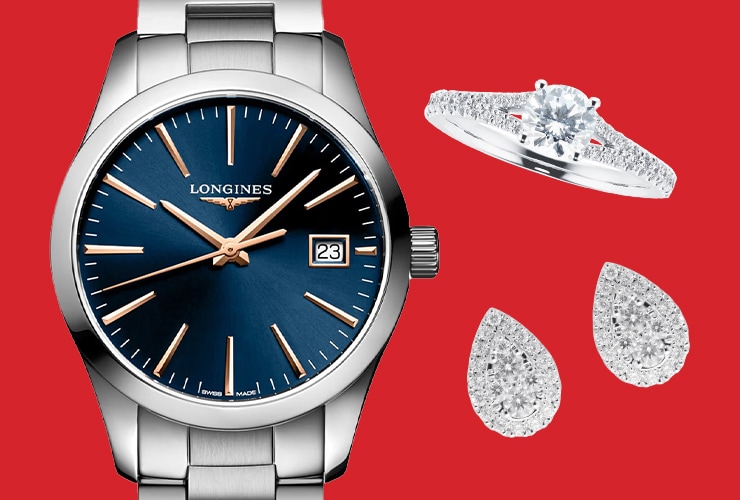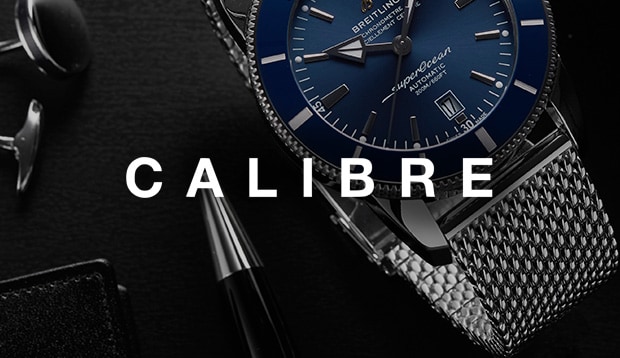-
SALE
Sale JewellerySale WatchesBy Price
-
Diamonds
By Category
-
Engagement
By Category
-
Weddings
Featured
- Jewellery
By CategoryBy Metal TypeBy GemstoneBy BrandBy Edit- Watches
By CategoryBy CollectionBy Luxury BrandBy Designer Brand- Rolex
FeaturedBy Collection- Rolex Certified Pre-Owned
- Brands
FeaturedBrands A-Z- Gifts
By CategoryBy PriceBy Popular Brand- Pre-Owned
By CategoryBy Brand- Sell Your Watch
Sell your watchWe will expertly assess your watch and offer you
a competitive and accurate valuation for the
watch you wish to sell to us.Free Instant Valuation
Drop off at any Showroom
Unrivalled Knowledge & Expertise- Editorial
- Jewellery
- Shop by Category
- SALE
- Diamonds
- Engagement Rings
- Weddings
-
Jewellery
- Back
- Jewellery Offers
- Shop All Jewellery
- Jewellery Home
- By Category
- By Metal Type
- By Gemstone
-
By Brand
- 886 by The Royal Mint
- Amor
- Bijoux Birks
- BOSS
- Calvin Klein
- Chopard
- Emporio Armani
- Fabergé
- FOPE
- FRED
- Georg Jensen
- Goldsmiths
- Gucci
- Jenny Packham
- Kiki McDonough
- Lauren By Ralph Lauren
- Mappin & Webb
- Marco Bicego
- MARIA TASH
- Messika
- Michael Kors
- Olivia Burton
- Pasquale Bruni
- Pomellato
- Repossi
- Roberto Coin
- Skagen
- Susan Caplan
- SUZANNE KALAN
- SWAROVSKI
- Ted Baker
- THOMAS SABO
- Tommy Hilfiger
- By Edit
-
Watches
- Back
- Watch Offers
- Shop All Watches
- Watches Home
- By Category
- By Collection
-
By Luxury Brand
- Rolex
- Rolex Certified Pre-Owned
- BALL
- Bamford
- Baume & Mercier
- Bell & Ross
- Blancpain
- Breitling
- Bremont
- Cartier
- CHANEL
- Chopard
- DOXA
- Frederique Constant
- Girard-Perregaux
- Glashütte Original
- Grand Seiko
- Gucci
- Hublot
- ID Genève
- IWC Schaffhausen
- Jaeger-LeCoultre
- Junghans
- Keris
- Longines
- MeisterSinger
- Montblanc
- Nivada Grenchen
- NOMOS Glashütte
- NORQAIN
- OMEGA
- Oris
- Panerai
- Piaget
- Rado
- RAYMOND WEIL
- TAG Heuer
- TUDOR
- Ulysse Nardin
- ZENITH
- By Designer Brand
- Rolex
- Rolex Certified Pre-Owned
-
Brands
- Back
- View All Brands
-
A-Z
- Rolex Watches
- Rolex Certified Pre-Owned
- 886 by The Royal Mint
- Accurist
- Amor
- Arnold & Son
- BALL
- Bamford
- Baume & Mercier
- Bell & Ross
- Blancpain
- Bijoux Birks
- BOSS
- Breitling
- Bremont
- BVLGARI
- Casio
- Calvin Klein
- Cartier
- Certina
- CHANEL
- Chopard
- Citizen
- Czapek
- DOXA
- Emporio Armani
- Encelade 1789
- Fabergé
- FOPE
- FRED
- Frederique Constant
- Garmin
- Georg Jensen
- Gerald Charles
- Girard-Perregaux
- Glashütte Original
- Goldsmiths
- Grand Seiko
- G-SHOCK
- Gucci
- Hamilton
- Hublot
- ID Genève
- IKEPOD
- IWC Schaffhausen
- Jacob & Co
- Jaeger-LeCoultre
- Jenny Packham
- Keris
- Kiki McDonough
- G-SHOCK
- Lauren By Ralph Lauren
- Longines
- Louis Erard
- Mappin & Webb
- Marco Bicego
- MARIA TASH
- Maurice Lacroix
- Michael Kors
- Messika
- Montblanc
- Nivada Grenchen
- NOMOS Glashütte
- NORQAIN
- Olivia Burton
- OMEGA
- Oris
- Panerai
- Parmigiani Fleurier
- Pasquale Bruni
- Piaget
- Pomellato
- QLOCKTWO
- Rado
- RAYMOND WEIL
- Repossi
- Roberto Coin
- Rolex
- Rolex Certified Pre-Owned
- Seiko
- Skagen
- Susan Caplan
- SUZANNE KALAN
- SWAROVSKI
- TAG Heuer
- Ted Baker
- THOMAS SABO
- Tissot
- Tommy Hilfiger
- TUDOR
- Ulysse Nardin
- Vivienne Westwood
- William Wood Watches
- WOLF
- ZENITH
- Gifts
-
Pre-Owned
- Back
- Shop Pre-Owned Watch Sale
- Shop All Pre-Owned
- Pre-Owned Home
- By Category
-
By Brand
- Rolex Certified Pre-Owned
- Pre-Owned Patek Philippe
- Pre-Owned TAG Heuer
- Pre-Owned Cartier
- Pre-Owned Jaeger-LeCoultre
- Pre-Owned Breitling
- Pre-Owned OMEGA
- Pre-Owned Longines
- Pre-Owned Tudor
- Pre-Owned IWC
- Pre-Owned Panerai
- Pre-Owned Blancpain
- Pre-Owned Breguet
- Pre-Owned Chopard
- Pre-Owned Rado
- Pre-Owned Vacheron Constantin
- Pre-Owned Zenith
- Sell Your Watch
- Editorial
- My Account
- Wishlist
- Store Finder
- Book an Appointment
- Help & Support
The Legendary Rolex Explorer Family - Buyer's Voice
By Bill Prince | 5 minute read

In common with several earlier attempts to conquer Everest, Sir John Hunt’s ultimately victorious bid to summit the world’s highest mountain 1953 was equipped with watches supplied by Rolex. Following Sir Edmund Hillary and Tenzing Norgay’s towering achievement, Rolex heralded the successful expedition by launching the Rolex Explorer, a watch that has come to embody the questing spirit of the adventurously-minded, and Rolex’s scrupulous approach to producing pioneering timepieces fit to accompany the very best of them.
In 1971 the original model was joined by the even more capable Explorer II, which this year celebrated its half century with a suitably subtle update. So we sat down with our head of watch buying, Mark Toulson, to discuss and review the latest iterations of the legendary Explorer family.
Calibre: So Mark, since we are discussing ground-breaking achievements, first things first: where for you does the Rolex Explorer sit in the pantheon of sports watches?
Mark Toulson: Well in some ways it’s the neglected sibling in the Professional range and I don’t necessarily think it should be. My understanding is that Rolex spent quite a lot of time producing a watch that could withstand extremes of temperatures, and the Explorer is very much an homage to that. So it’s a tough watch, probably one of their toughest watches, and it’s designed for explorers and anyone with an adventurous spirit.
Calibre: Agreed. You certainly can’t take away from Rolex its investment into testing its watches ‘IRL’ as we say, having been involved in attempts on Everest since the Thirties. The Oyster had really earned its spurs by the time Hillary summited Everest in 1953, which gave birth to the Explorer as we know it today. And this year two new models return it to its original 36mm size. What do you think of that?
Mark Toulson: It’s interesting: we’re seeing a general move into smaller sizes. Obviously, that’s relative to where it’s coming from - between 40 and 43mm is where most of the action is in terms of sales because that is where most mens’ watches sit – but we saw lots of brands last year introduce slightly smaller case sizes and the direction of travel is towards 40mm. And the previous Explorer being 39mm, it’s clearly heading in that same direction of travel. But the key thing - or rather the iconic thing - is of course that besides the inverted triangle at 12 o’clock you always get on the Explorer, you have the 3, 6, 9 Arabic numeral layout which you won’t find on the current Oyster Perpetual collection. There isn’t a black option on the Oyster Perpetual either, so if you want an iconic dial configuration that has legibility as one of its keynote features, it does kind of push you in the direction of the Explorer.
Calibre: Which brings us to the new model in Rolesor yellow gold and Oystersteel. Predictably some diehards who prefer their ‘tool watches’ to remain ‘au naturel’ have chafed at the use of precious metal on what began life as a stainless steel watch. What is your feeling?
Mark Toulson: Well I wasn’t expecting it, but then hindsight is a wonderful thing isn’t it? But you will remember the Sea Dweller came out in steel and yellow a few years ago and obviously the Submariner has been in steel and yellow forever, so they have form for Professional watches in mixed metal. So maybe the idea was, we’ve done it before, we can do it with this model.
And if you leave the bracelet aside, there was also the 6299 which came out in the Fifties which had yellow gold bezel and crown and had the word ‘Explorer’ on the dial, so we’ve been here before. I think it looks good. It does give you another option, but it is still an Explorer.
Calibre: And we should reflect on that because apart from the striking new colourway, it retains all of the hallmarks of the founding father of the Professional series - the Mercedes hands, the 3, 6, 9 Arabic numerals, baton hour markers, now lit with Chromolight, which adds a deep blue hue the lume. Nor should we forget the advanced 3230 movement which offers a weekend’s worth of power reserve, which in today’s world is worth its weight in Rolesor…
Mark Toulson: And the bracelet gets the new Oysterlock folding clasp with easy-link adjustment that gives you that little bit of play if your wrist is having a “fatter” day…..
Calibre: Well, we’ve covered off one of the main talking points, but another talking point amongst the Rolex cognoscenti was how relatively untouched the 50th anniversary Explorer II model is, relative to what people were maybe expecting of an ‘anniversary’ edition.
Mark Toulson: Yes, this one we were all expecting, obviously, because its 50 years old this year. And I guess like you, I looked at what people were doing on the blogs and the forums beforehand and there were people who were really good with digital imaging putting a ceramic bezel on it, and I was thinking, no, no, no - it should be steel, this is a utilitarian sports watch originally designed for potholers and people in the artic who don’t know whether it’s day or night, So it should stay with a steel aesthetic and not go down the ceramic route.
Calibre: You’re absolutely right, at launch in 1971 it was as if Rolex had created the world’s first ‘Extreme sports’ watch before anyone was talking about extreme sports. It was designed with a largely scientific role in mind, allowing the wearer to tell the time day or night, regardless of the ambient light conditions, whether that was deep underground or in an artic summer or winter. That said, there are some subtle aesthetic changes, such as the dot hour markers and Mercedes hands that replace the batons and straight hands of the 1971 original. This has also been equipped with Rolex’s new Chromolight lume, which means its even more potent in the dark. But what were your first impressions?
Mark Toulson: Well at 42mm it’s relatively big for a Rolex sports watch, but they have upgraded the bracelet in the same way as they have done with the Explorer, and similarly they’ve updated the movement to the 3285 calibre, so, again, you have 70 hours’ power reserve.

Calibre: At which point you could say that if you’re looking for a highly functional wristwatch with a useful GMT function, you need to decide between the romantic appeal of the GMT-Master II pilot’s watch and the rugged Explorer II, which, thanks to its nickel-phosphorous Chronergy escapement now moves closer towards Milgauss territory. But in their own right, would you agree that the new Explorer pieces are good to go for another 50 years?
Mark Toulson: I would say so. In many ways, it’s more about evolution than revolution with Rolex, and the small changes they make are always valid, they are never an affectation and they are true to Rolex: The Explorer is a tough watch and remains so. Another 50 years? It’s hard to see what they could improve. Maybe technology will improve and even more will be to the movements, but essentially it’s a design that works. And you don’t mess with something that works.
Calibre: Which only leaves one question: if you had to choose between the Explorer II’s dial options – black or white lacquer – which one would you go for?
Mark Toulson: Well I’ve always wanted a white lacquered dial and never have. I really like it and it’s a cool-looking watch.
Calibre: Personally I think everyone should own a white-dialled sports watch. Because, come summer, particularly if you are lucky enough to have a tanned wrist, there is something about a white-dialled sports watch that suits summer and summer suits it.
Mark Toulson: Yes you’re right. I hadn’t thought about that, and there aren’t that many white dial sports watches around are there? But you’ve reminded me of something else about the Explorer II – and whether or not this was deliberate I don’t know – but people in caves where it’s dark all the time, and people at the poles where for half the year it’s light all the time…
Calibre: Exactly - you need one of each!
Discover more from Rolex here at Goldsmiths.
Sign Up For Calibre Newsletter
Get a round up of the latest stories from Calibre every month, directly to your inbox.
© 2025 Goldsmiths
Goldsmiths is a trading name of Watches of Switzerland Company Limited. Registered Office: Aurum House, 2 Elland Road, Braunstone, Leicester, LE3 1TT, Registered in England and Wales, Company number 00146087. Registered VAT Number 834 8634 04. Watches of Switzerland Company Limited acts as a broker and not a lender and offers finance from Secure Trust Bank PLC trading as V12 Retail Finance and PayPal UK Ltd, 5 Fleet Place, London, United Kingdom, EC4M 7RD trading as PayPal Credit. Watches of Switzerland Company Limited is authorised and regulated by the Finance Conduct Authority. Our registration number is 308710. *Credit is provided subject to affordability, age and status. Minimum spend applies. Terms and Conditions apply. UK residents only. Not all products are regulated by the Financial Conduct Authority and FOS protection will not be extended to unregulated agreements. Please note the Consumer Credit Act states that should your purchase / loan amount cost more than £30,000 you will not be covered under Section 75 of the Consumer Credit Act.
*Next day delivery available on most items. See product pages for more information.









